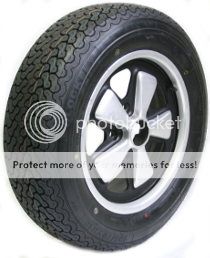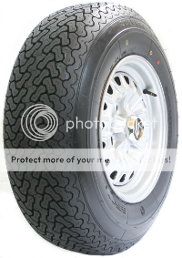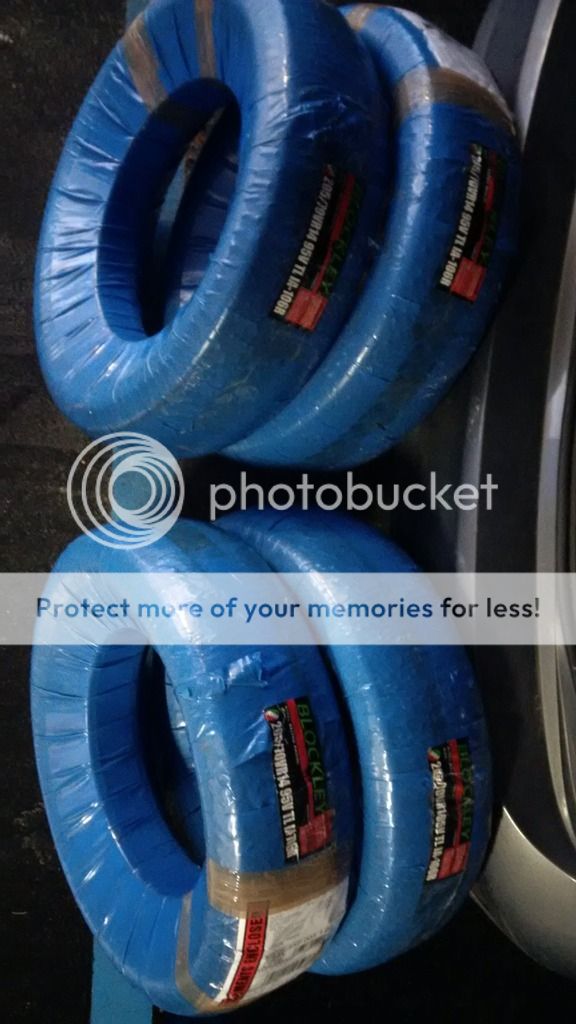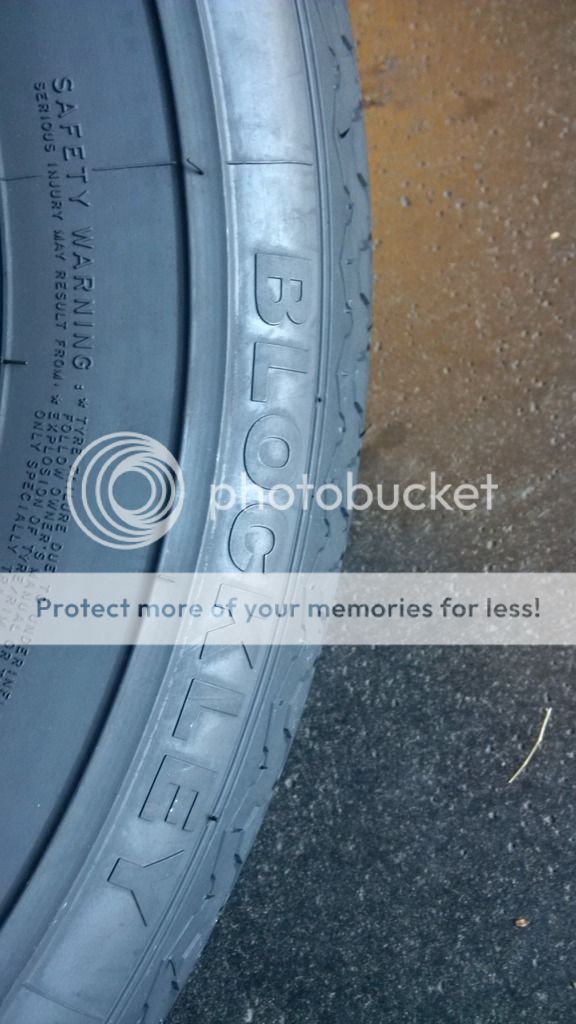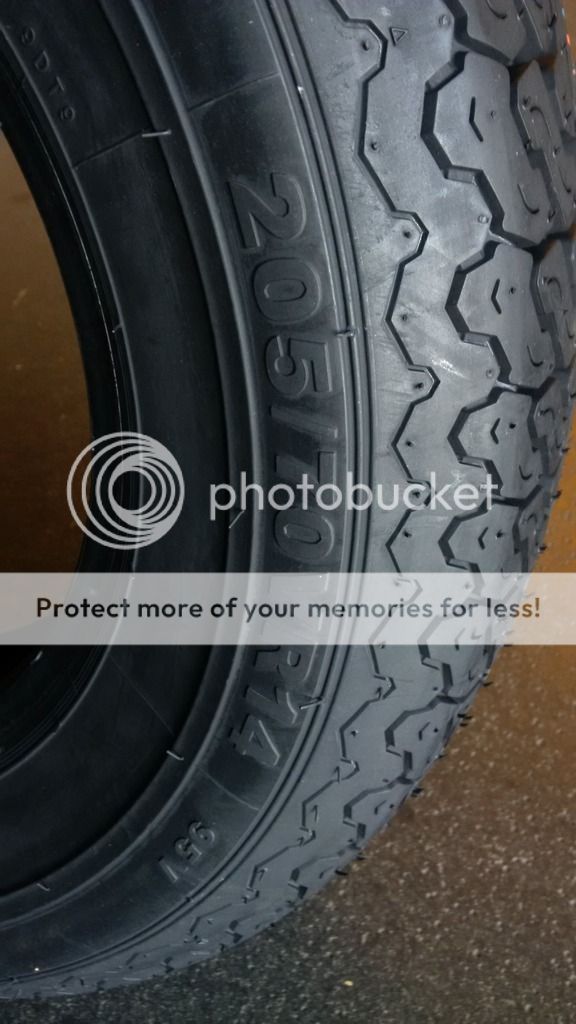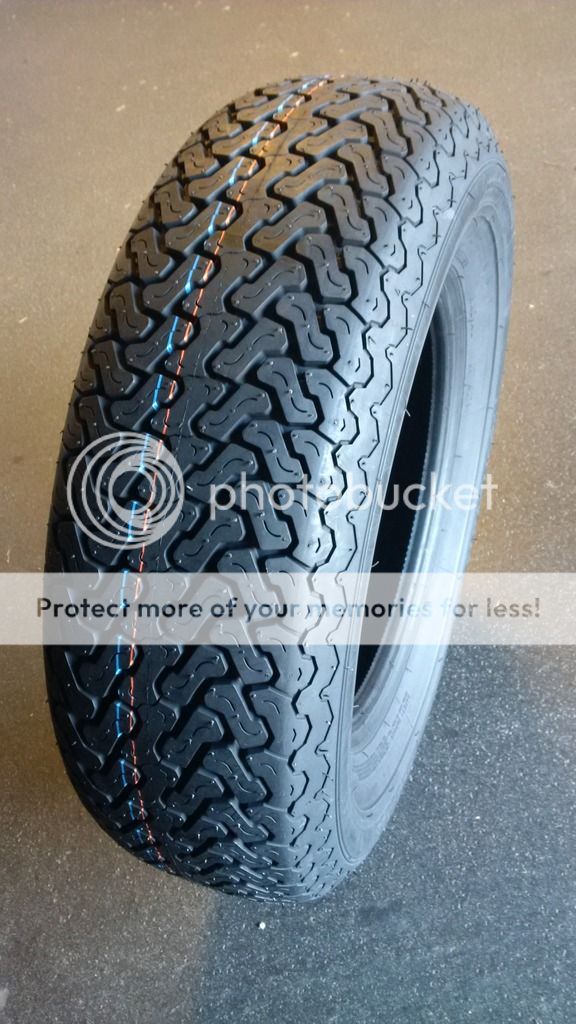You are using an out of date browser. It may not display this or other websites correctly.
You should upgrade or use an alternative browser.
You should upgrade or use an alternative browser.
yes, another tyre thread,..anyone blockleys ?
- Thread starter deQuincey
- Start date
supposed to be a british company, but not a single word on manufacturing, who produces them ? where ?
his publicity says:
I formed this company because I needed tyres to fit a Grand Prix (26M) Maserati that was in the process of restoration, and this was the only way of obtaining the highest quality period looking tyres for the job. A genuine high speed road tyre that is also suitable for competition purposes. For many years I had made approaches to Dunlop to produce such a tyre, both directly and through people dealing closely with them but to no avail - apart from establishing that they no longer had any of the drawings or old moulds to look at. I suspect they were not interested because they could not envisage the tyre I had in mind increasing the volume of their sales i.e. they would only be sold at the expense of either their road tyre, or their race tyre. My own view is that their road tyres, with the pseudo 1950's tread pattern (although no worse than many other makes), are not authentic looking enough. Also many people do not want to use their race tyre because of the large cross section and recommended rim widths, which are out of character with the cars themselves.
Initially I wanted to produce the highest quality tyre suitable for pre war cars - with authentic appearance and handling characteristics. These are the first tyres produced for pre war (and early post war) cars that are not only suitable for road and competition use but are manufactured to the highest standards of the industry as demonstrated by the high speed rating. Blockley tyres have set the new benchmark, which other manufacturers have now tried to emulate, which is why we ask customers to
his publicity says:
I formed this company because I needed tyres to fit a Grand Prix (26M) Maserati that was in the process of restoration, and this was the only way of obtaining the highest quality period looking tyres for the job. A genuine high speed road tyre that is also suitable for competition purposes. For many years I had made approaches to Dunlop to produce such a tyre, both directly and through people dealing closely with them but to no avail - apart from establishing that they no longer had any of the drawings or old moulds to look at. I suspect they were not interested because they could not envisage the tyre I had in mind increasing the volume of their sales i.e. they would only be sold at the expense of either their road tyre, or their race tyre. My own view is that their road tyres, with the pseudo 1950's tread pattern (although no worse than many other makes), are not authentic looking enough. Also many people do not want to use their race tyre because of the large cross section and recommended rim widths, which are out of character with the cars themselves.
Initially I wanted to produce the highest quality tyre suitable for pre war cars - with authentic appearance and handling characteristics. These are the first tyres produced for pre war (and early post war) cars that are not only suitable for road and competition use but are manufactured to the highest standards of the industry as demonstrated by the high speed rating. Blockley tyres have set the new benchmark, which other manufacturers have now tried to emulate, which is why we ask customers to
i am interested in comparing them to michelin xwx and vredestein sprint classic for a 205/70VR14 size
michelin xwx
vredestein sprint classic.
blockley.
it seems that michelin is out of my reach, the two others are very close, should i give a try to blockleys ?
michelin xwx
vredestein sprint classic.
blockley.
it seems that michelin is out of my reach, the two others are very close, should i give a try to blockleys ?
Last edited:
Those tires are an expensive way of getting a 1950's look.
Instead you can buy hair spray for $12.95 and be Elvis with a nice Pompadour ...
Extra benefit, you may also get nominated for the US primaries.
Instead you can buy hair spray for $12.95 and be Elvis with a nice Pompadour ...
Extra benefit, you may also get nominated for the US primaries.
Did Elvis prefer bias belted or radials? Vogues? Or Firestone LXX?
dQ:
I have no familiarity with Blockley, but the promotional material seems mostly focused on tires for "pre-War" and slightly later vehicles that used inner tubes.:o
You are certainly aware that XWX's were the cutting edge in the early '70s - and some used tubes. Michelin XWX video => https://www.youtube.com/watch?v=Yz18S_h1qBI Even when they were comparatively less expensive than today, they handled well but the tread seemed to disappear faster than a few tanks of petrol. With that in mind, if you intend to use the tires for daily use - you might consider a more modern and durable rubber compound.
If you are purely seeking authenticity at minimal expense, Blockley, being fairly close to you, may be a suitable substitution. However, it is hard to determine with any certainty how the tires are constructed and by whom, so you may be the first to test them. Given the photos on the Buckley site, I would expect Porsche purists might have some experience and opinions on the subject. And, you are probably aware that there are other manufacturers/vendors of older style tires you might also consider. For example, Coker Tires https://www.cokertire.com/tires/styles/european/michelin-mxv-p.html https://www.cokertire.com/catalogsearch/result/?q=xwx&order=bestsellers - although admittedly the prices seem steeper than Blockley.
Tire Rack, mentioned on this forum before ( http://tires.tirerack.com/tires/205 70 14 ) http://www.e9coupe.com/forum/showthread.php?t=2555 http://www.e9coupe.com/forum/showthread.php?t=21134 or their Euro equivalent might offer some other alternatives.

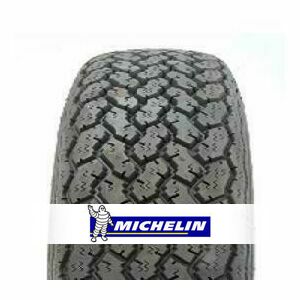
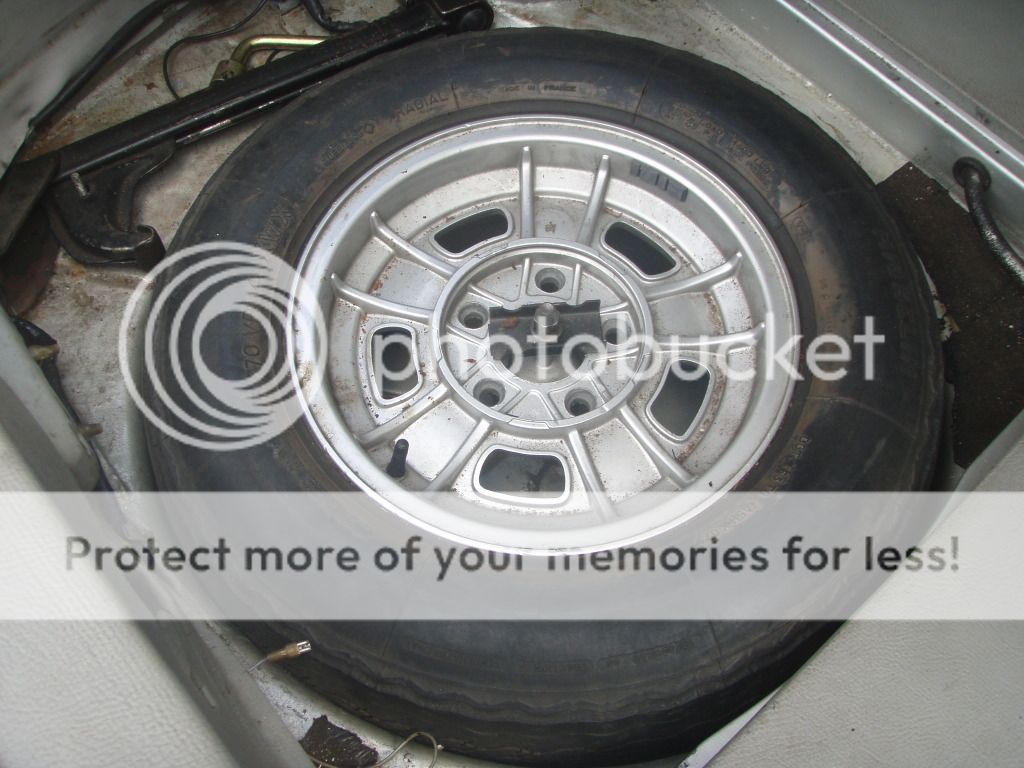
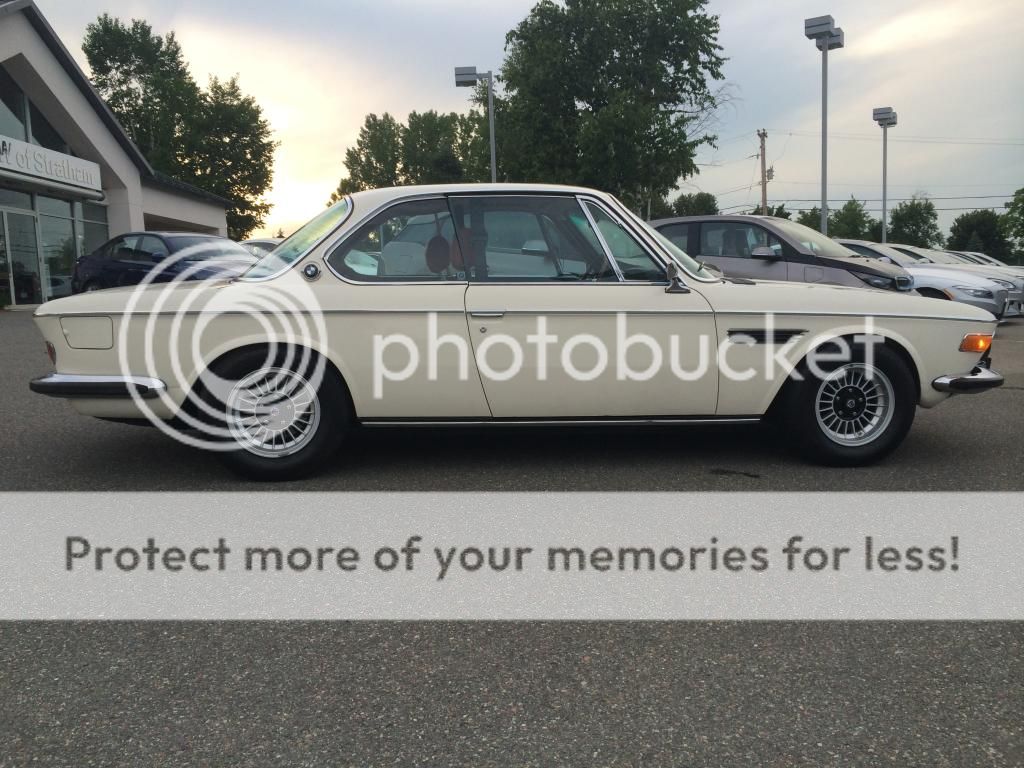


http://www.madle.org/elxx.htm
dQ:
I have no familiarity with Blockley, but the promotional material seems mostly focused on tires for "pre-War" and slightly later vehicles that used inner tubes.:o
You are certainly aware that XWX's were the cutting edge in the early '70s - and some used tubes. Michelin XWX video => https://www.youtube.com/watch?v=Yz18S_h1qBI Even when they were comparatively less expensive than today, they handled well but the tread seemed to disappear faster than a few tanks of petrol. With that in mind, if you intend to use the tires for daily use - you might consider a more modern and durable rubber compound.
If you are purely seeking authenticity at minimal expense, Blockley, being fairly close to you, may be a suitable substitution. However, it is hard to determine with any certainty how the tires are constructed and by whom, so you may be the first to test them. Given the photos on the Buckley site, I would expect Porsche purists might have some experience and opinions on the subject. And, you are probably aware that there are other manufacturers/vendors of older style tires you might also consider. For example, Coker Tires https://www.cokertire.com/tires/styles/european/michelin-mxv-p.html https://www.cokertire.com/catalogsearch/result/?q=xwx&order=bestsellers - although admittedly the prices seem steeper than Blockley.
Tire Rack, mentioned on this forum before ( http://tires.tirerack.com/tires/205 70 14 ) http://www.e9coupe.com/forum/showthread.php?t=2555 http://www.e9coupe.com/forum/showthread.php?t=21134 or their Euro equivalent might offer some other alternatives.




http://www.madle.org/elxx.htm
Last edited:
Great info Lloyd.
Don't know about Elvis, but I know DQ and he is a purist.
I predict that DQ will get the Blockley tires and then find a way of filling them with air from the 70s. Next thread is on how to extract old air trapped in glaciers for vintage tires .
.
Don't know about Elvis, but I know DQ and he is a purist.
I predict that DQ will get the Blockley tires and then find a way of filling them with air from the 70s. Next thread is on how to extract old air trapped in glaciers for vintage tires
lsquaredb
Well-Known Member
My dad's 2800CS came with Conti DR70-14 tires when it was new, and they had tubes. The manual specified tubes too. The Contis wore out in less that 15,000 miles. They were replaced with tubeless Yokohamas which looked very much like the Blockleys.
Great info Lloyd.
Don't know about Elvis, but I know DQ and he is a purist.
I predict that DQ will get the Blockley tires and then find a way of filling them with air from the 70s. Next thread is on how to extract old air trapped in glaciers for vintage tires.
I am literally laughing out loud. My coworkers are glaring at me.
Great info Lloyd.
Don't know about Elvis, but I know DQ and he is a purist.
I predict that DQ will get the Blockley tires and then find a way of filling them with air from the 70s. Next thread is on how to extract old air trapped in glaciers for vintage tires.
i wonder why am i unable to produce such brilliant thoughts
a masterpiece !
Or perhaps can search for air tanks in abandoned garages.
Mr. Haney
I just so happen to have some vintage air here in my truck Mr. Douglass, it's not expensive at all considering it's antique. I could let you have it for the small sum of say $ _______
I just so happen to have some vintage air here in my truck Mr. Douglass, it's not expensive at all considering it's antique. I could let you have it for the small sum of say $ _______
EJ333
Well-Known Member
Great info Lloyd.
Don't know about Elvis, but I know DQ and he is a purist.
I predict that DQ will get the Blockley tires and then find a way of filling them with air from the 70s. Next thread is on how to extract old air trapped in glaciers for vintage tires.
Priceless! LOL
blockleys on their way with DHL ...:-! will meet them soon 
yes i will probably the first one here to test them
yes i will probably the first one here to test them
Mr. Haney
I just so happen to have some vintage air here in my truck Mr. Douglass, it's not expensive at all considering it's antique. I could let you have it for the small sum of say $ _______
"See Oliver... I told you we would find the right air for your Continental in Hooterville.."
Aussiecsi
Well-Known Member
"See Oliver... I told you we would find the right air for your Continental in Hooterville.."
...maybe some methane gas from Arnold Ziffel might be a good substitute ?
some data to compare:
Blockley Radial 205/70VR14 95V TL
Tyre Size: 205/70VR14
Overall Diameter: 642 mm
Overall Width: 205 mm
Tread Width:152 mm
Max Load: 690 kg
Max Speed: 240 km/h
Permitted Rim Widths: 5½" - 7"
Optimum Rim: 6"
EEC certification: E-marked
Michelin Radial 205/70VR14 89W TL
Tyre Size: 205/70VR14
Overall Diameter: 644 mm
Overall Width: 209 mm
Tread Width:
Max Load: 580 kg
Max Speed: 270 km/h
Permitted Rim Widths: 5½" - 7½"
Optimum Rim: 6"
EEC certification: E-marked
Blockley Radial 205/70VR14 95V TL
Tyre Size: 205/70VR14
Overall Diameter: 642 mm
Overall Width: 205 mm
Tread Width:152 mm
Max Load: 690 kg
Max Speed: 240 km/h
Permitted Rim Widths: 5½" - 7"
Optimum Rim: 6"
EEC certification: E-marked
Michelin Radial 205/70VR14 89W TL
Tyre Size: 205/70VR14
Overall Diameter: 644 mm
Overall Width: 209 mm
Tread Width:
Max Load: 580 kg
Max Speed: 270 km/h
Permitted Rim Widths: 5½" - 7½"
Optimum Rim: 6"
EEC certification: E-marked
Last edited:
a tyre sidewall is full of information, lets see
funny enough they do not mention the productin date usually as week/ year. ( 0216) second week 2016
Here’s how to decode it all:
1.) “245”: The numbers preceding the slash indicate the distance, in millimeters, across the widest point of the tire—called section width (245mm, or 9.65 inches, in this case)—when mounted on a wheel of specified width. Often listed before this number are letters that loosely signify the kind of duty for which the tire was designed: “P” stands for “p-metric” and is generally used on passenger cars, “LT” indicates light-truck duty, and “T” is for a temporary spare.
2.) “40”: This two-digit number is the aspect ratio, or profile, of the sidewall. This tire’s sidewall height is 40 percent of the tire’s width, which equates to 98mm, or 3.86 inches. The lower the number, the shorter the sidewall. An exception is Michelin PAX tires, where this number signifies the overall diameter of the tire in millimeters.
3.) “R”: This letter indicates radial tire construction; nearly all tires sold today are of this variety. Other constructions are “D” for bias-ply tires and “B” for belted. A preceding “Z” is simply a reference to an outdated and vague speed rating of more than 240 km/h, or 149 mph (the specific rating can be found in the service description).

4.) “18”: This number indicates the diameter of the wheel on which the tire should be mounted, generally in inches. These are usually whole numbers but can also be half-inch increments, such as “16.5,” or in millimeters, as in “390.”
5.) SERVICE DESCRIPTION: These numbers and letter together are called the service description. The numbers indicate the tire’s maximum “load” rating, or the amount of weight the tire can bear (“93” stands for 650 kilograms, or 1433 pounds), and the letter denotes the speed rating, or how fast the tires can safely rotate (“W” means 270 km/h, or 168 mph). The lowest rating typically found on passenger-car tires is “Q,” which means 99 mph. The highest, “Y,” is good for 186 mph, and when enclosed in parenthesis, as in “(93Y),” it means “in excess of” 186 mph. These values are determined by tire-testing machines in a lab, and the decoded load rating is also listed elsewhere on the tire.
6.) RED DOT: Here’s a long-held myth that can be put to rest: It doesn’t help in the balancing process to align the “heavy spot” of a tire—often indicated with a red dot—with a wheel’s valve stem when mounting. Aluminum wheels are now the norm, and the valve stem is no longer the de facto lightest point.
7.) “200”: The tread-wear grade is a relative figure based on the rate of wear of a tire during a 7200-mile on-vehicle test compared with that of a reference tire. The higher the number, the longer it will likely last. “300” indicates that the tire should last three times longer than the Uniroyal reference tire, which scores 100.
8.) “A”: A tire gets a seemingly uninformative traction grade (“AA,” “A,” “B,” or “C”) based on how much grip it generates in a straight-line test in which the tire is dragged at 40 mph across a wet surface without being allowed to rotate at all.
9.) “A”: This letter indicates a tire’s ability to dissipate heat. As heat increases dramatically at high speed, this is, in effect, a second, less precise speed rating. “A” means the tire can withstand speeds over 115 mph, “B” is for between 100 and 115 mph, and “C” means between 85 to 100 mph.
10.) “M+S”: This stands for “mud and snow” and simply means that the tire has more space between the treads, which should help to facilitate traction on soft surfaces.
11.) “MOUNTAIN SNOWFLAKE”: Unlike the M+S rating, this icon indicates that a tire has met a minimum performance requirement in snow testing.
12.) ORIGINAL EQUIPMENT (OE) MARKING: These letters—or a symbol—indicate that this is the automaker-specified version of a tire that came as a car’s original equipment. These tires can often be a very different blend of rubber compound compared with the off-the-shelf variety of the same tire, even though the tread pattern is identical. Examples of OE markings: General Motors—all have a TPC SPEC number; BMW—most have a five-pointed-star symbol; Mercedes—some are emblazoned with “M0”; Porsche—all have the letter “N” followed by a number, i.e., N1, N2, etc.
13.) TIRE CONSTRUCTION MATERIALS: This is a required and self-explanatory list of the reinforcing materials and number of layers (in both the tread and the sidewall) that are molded into a tire’s rubber for reinforcement.
14.) DOT LABEL: Every tire sold in the U.S. must have U.S. Department of Transportation (DOT) labeling. The first two characters indicate the factory of manufacture, and the next five or six are manufacturer-specific jargon (for tracking purposes, as in the case of a recall). The last four numbers give the date of production (the first two indicate which of 52 weeks, and the second two, the year). The European equivalent of the DOT code may also be present (it starts with an “e”), although fewer manufacturers are printing both on a tire’s sidewall (to prevent gray-market shipments when currency exchange rates fluctuate). If this string of numbers ends with “-S,” it means the tire complies with European noise regulations.
funny enough they do not mention the productin date usually as week/ year. ( 0216) second week 2016
Here’s how to decode it all:
1.) “245”: The numbers preceding the slash indicate the distance, in millimeters, across the widest point of the tire—called section width (245mm, or 9.65 inches, in this case)—when mounted on a wheel of specified width. Often listed before this number are letters that loosely signify the kind of duty for which the tire was designed: “P” stands for “p-metric” and is generally used on passenger cars, “LT” indicates light-truck duty, and “T” is for a temporary spare.
2.) “40”: This two-digit number is the aspect ratio, or profile, of the sidewall. This tire’s sidewall height is 40 percent of the tire’s width, which equates to 98mm, or 3.86 inches. The lower the number, the shorter the sidewall. An exception is Michelin PAX tires, where this number signifies the overall diameter of the tire in millimeters.
3.) “R”: This letter indicates radial tire construction; nearly all tires sold today are of this variety. Other constructions are “D” for bias-ply tires and “B” for belted. A preceding “Z” is simply a reference to an outdated and vague speed rating of more than 240 km/h, or 149 mph (the specific rating can be found in the service description).

4.) “18”: This number indicates the diameter of the wheel on which the tire should be mounted, generally in inches. These are usually whole numbers but can also be half-inch increments, such as “16.5,” or in millimeters, as in “390.”
5.) SERVICE DESCRIPTION: These numbers and letter together are called the service description. The numbers indicate the tire’s maximum “load” rating, or the amount of weight the tire can bear (“93” stands for 650 kilograms, or 1433 pounds), and the letter denotes the speed rating, or how fast the tires can safely rotate (“W” means 270 km/h, or 168 mph). The lowest rating typically found on passenger-car tires is “Q,” which means 99 mph. The highest, “Y,” is good for 186 mph, and when enclosed in parenthesis, as in “(93Y),” it means “in excess of” 186 mph. These values are determined by tire-testing machines in a lab, and the decoded load rating is also listed elsewhere on the tire.
6.) RED DOT: Here’s a long-held myth that can be put to rest: It doesn’t help in the balancing process to align the “heavy spot” of a tire—often indicated with a red dot—with a wheel’s valve stem when mounting. Aluminum wheels are now the norm, and the valve stem is no longer the de facto lightest point.
7.) “200”: The tread-wear grade is a relative figure based on the rate of wear of a tire during a 7200-mile on-vehicle test compared with that of a reference tire. The higher the number, the longer it will likely last. “300” indicates that the tire should last three times longer than the Uniroyal reference tire, which scores 100.
8.) “A”: A tire gets a seemingly uninformative traction grade (“AA,” “A,” “B,” or “C”) based on how much grip it generates in a straight-line test in which the tire is dragged at 40 mph across a wet surface without being allowed to rotate at all.
9.) “A”: This letter indicates a tire’s ability to dissipate heat. As heat increases dramatically at high speed, this is, in effect, a second, less precise speed rating. “A” means the tire can withstand speeds over 115 mph, “B” is for between 100 and 115 mph, and “C” means between 85 to 100 mph.
10.) “M+S”: This stands for “mud and snow” and simply means that the tire has more space between the treads, which should help to facilitate traction on soft surfaces.
11.) “MOUNTAIN SNOWFLAKE”: Unlike the M+S rating, this icon indicates that a tire has met a minimum performance requirement in snow testing.
12.) ORIGINAL EQUIPMENT (OE) MARKING: These letters—or a symbol—indicate that this is the automaker-specified version of a tire that came as a car’s original equipment. These tires can often be a very different blend of rubber compound compared with the off-the-shelf variety of the same tire, even though the tread pattern is identical. Examples of OE markings: General Motors—all have a TPC SPEC number; BMW—most have a five-pointed-star symbol; Mercedes—some are emblazoned with “M0”; Porsche—all have the letter “N” followed by a number, i.e., N1, N2, etc.
13.) TIRE CONSTRUCTION MATERIALS: This is a required and self-explanatory list of the reinforcing materials and number of layers (in both the tread and the sidewall) that are molded into a tire’s rubber for reinforcement.
14.) DOT LABEL: Every tire sold in the U.S. must have U.S. Department of Transportation (DOT) labeling. The first two characters indicate the factory of manufacture, and the next five or six are manufacturer-specific jargon (for tracking purposes, as in the case of a recall). The last four numbers give the date of production (the first two indicate which of 52 weeks, and the second two, the year). The European equivalent of the DOT code may also be present (it starts with an “e”), although fewer manufacturers are printing both on a tire’s sidewall (to prevent gray-market shipments when currency exchange rates fluctuate). If this string of numbers ends with “-S,” it means the tire complies with European noise regulations.
talked to the blockleys guys about this:
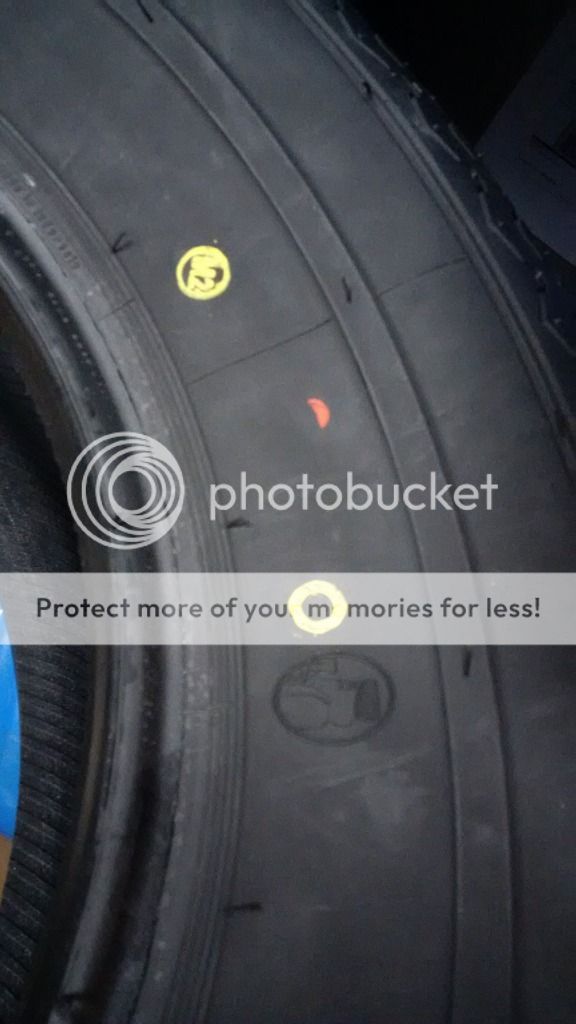
"When the tyres are made we also afterwards check them to make sure the balance is good, because we have a high speed rating. The yellow circle is where the tyre is the lightest. Michelin used to do this in the past. So people often fit the lightest part of the tyre to the heaviest part of the wheel - where the valve stem is.
PS Sometimes tyres also have a red dot which is the heavy part - when the red and yellow are close it means a perfect balance. . .
"


"When the tyres are made we also afterwards check them to make sure the balance is good, because we have a high speed rating. The yellow circle is where the tyre is the lightest. Michelin used to do this in the past. So people often fit the lightest part of the tyre to the heaviest part of the wheel - where the valve stem is.
PS Sometimes tyres also have a red dot which is the heavy part - when the red and yellow are close it means a perfect balance. . .
"

done

and tested,
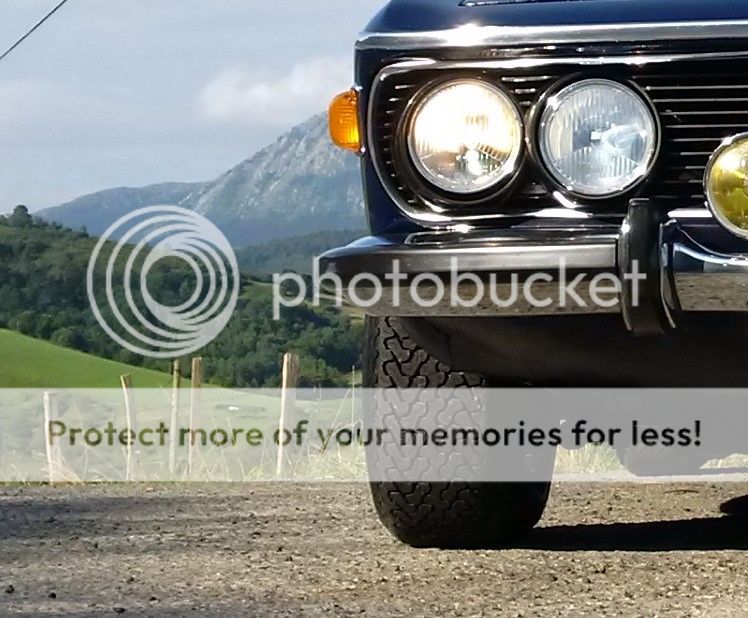
no matter the circumstances,
no matter where, when, and how,
straights, turns, braking, cornering fast or slow, uphill or downhill, fast or faster, 980 or 6000 rpms,
no matter the question,...the answer is : B l o c k l e y s
they are superior to whatever i have been driving the coupe on,
...strong, flexible, quiet, superb grip, they are perfectly built, amazingly equilibrated and centered, a tread wear grade of 280, they are extremely reasonably priced, and they look awesome in the coupe (IMHO), judge by yourself:
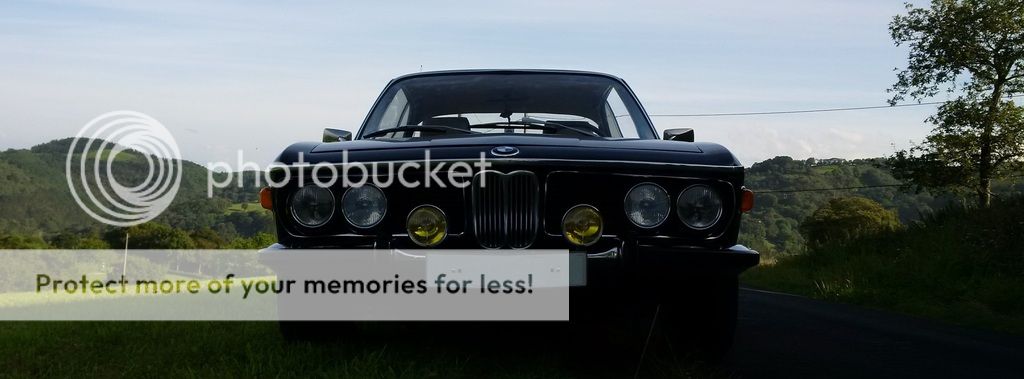
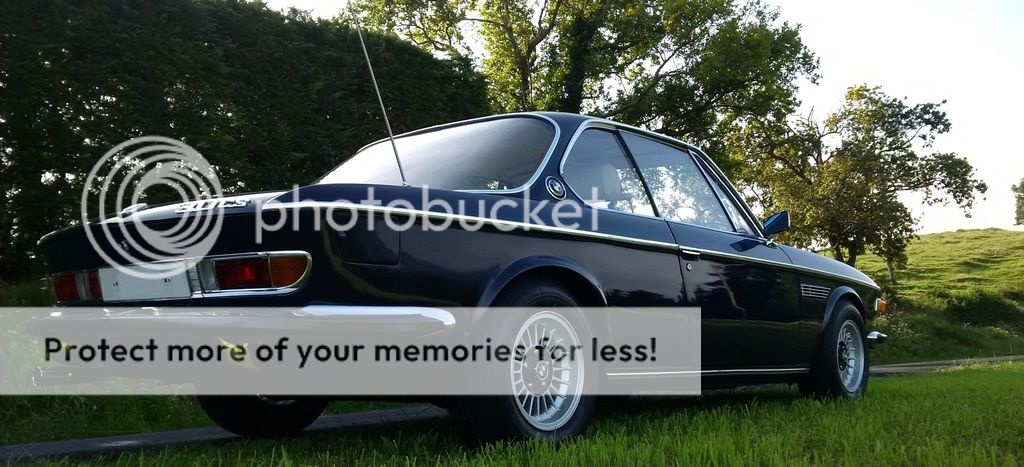
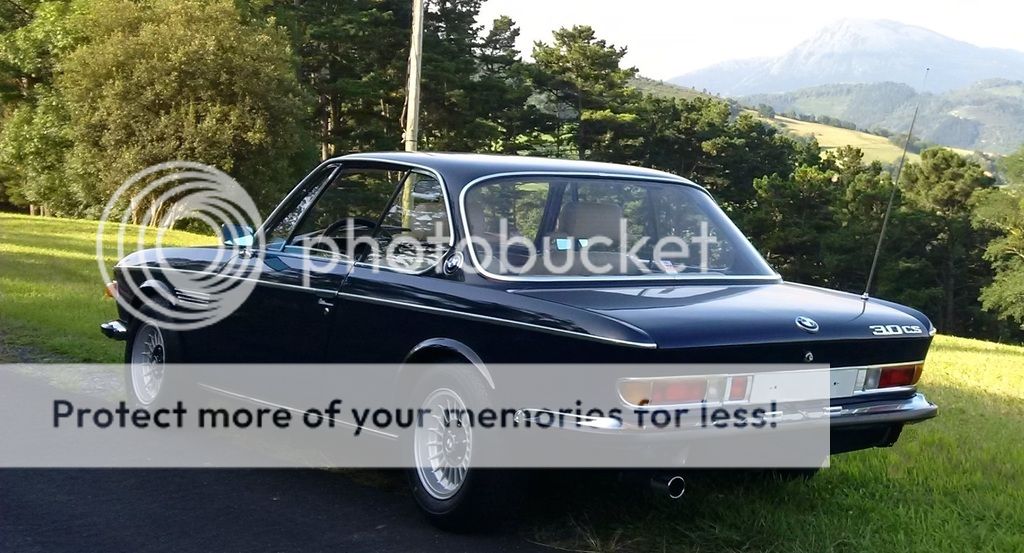


talk to Julian, he is a gentleman, a true spirited car lover and a fantastic racer in his pre and post-war cars
a real pleasure,
(BTW. vielen danke Patrick )
)

and tested,

no matter the circumstances,
no matter where, when, and how,
straights, turns, braking, cornering fast or slow, uphill or downhill, fast or faster, 980 or 6000 rpms,
no matter the question,...the answer is : B l o c k l e y s
they are superior to whatever i have been driving the coupe on,
...strong, flexible, quiet, superb grip, they are perfectly built, amazingly equilibrated and centered, a tread wear grade of 280, they are extremely reasonably priced, and they look awesome in the coupe (IMHO), judge by yourself:





talk to Julian, he is a gentleman, a true spirited car lover and a fantastic racer in his pre and post-war cars
a real pleasure,
(BTW. vielen danke Patrick

